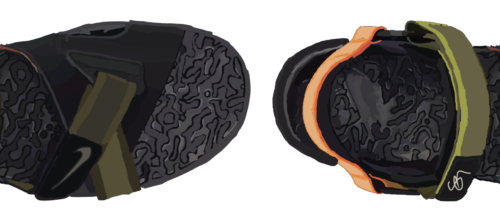This summer, one pair of shoes changed my life: the “Nike x Sig Zane ACG Deschütz+” sandal. The name is a mouthful, but after saying it over a hundred times it rolls off the tongue. So without further ado, the Arts Editor of the Harvard Independent declares the “Nike x Sig Zane ACG Deschütz+” the inaugural Shoe of the Summer.
What does it mean to be the Shoe of the Summer? This year, summer was about rebirth and reflection after a tumultuous year and a half. A shoe for this summer had to be technically freeing and comforting but also stylistically new and refreshing. For Harvard students, the shoe has to be able to stand up to Cambridge’s muggy heat and historic cobblestone. It is no surprise then that our shoe is a product of an exciting collaboration between Nike and Sig Zane, a clothing brand based in Hilo, Hawaii. I sat down with Kuhao Zane, designer of the shoe for Sig Zane, to learn about how his Hawaiian heritage influenced his design style.
I stumbled upon this shoe by accident. On the Nike SNKRs application, this pair of Deschütz stands out between Nike SBs and Jordans. Introduced in 1992 as an anti-fashion sandal for the outdoors, the Nike ACG team revived it for summer 2020 as the pandemic drove people to nature. A competitive offering to Tevas and Birkenstocks, the shoe instantly became a cult favorite as the refreshed rubber sole with Nike Air technology rivals the comfort of the Adidas Boost midsole. I wore these open-toed sandals playing pickup basketball, hiking through forests, climbing through castles, and out at night.
While the shoe itself provides the comfort and performance characteristic of Nike, the detail of its design adds so much more. Delicate ornamentation covers the shoe, from the cross-foot flap, to the ankle strap and the inside of the heel cap.
The most remarkable single feature on the Deschütz is its subtle black floral upper. (Kuhao is credited by Dale Hope, the expert on the Aloha shirt, as the man who invented the black-on-black Aloha shirt.) Even more striking is the remarkable color scheme throughout the shoe. What might be superficially described as camouflage, is actually the exact opposite; the colors are inspired by the O’hio, a flower critical to feeding the aquifers of the Big Island in Hawaii. “I found the colors by bringing Pantone swatches into the forest,” Kuhao said.
The connection between functionality, aesthetics, and culture is distinct to Kuhao’s style. Kuhao Zane started off by designing Aloha t-shirts in high school. His father, Sig Zane, revolutionized Aloha shirts by focusing his design ethos on Hawaiian plants. At a party in Hilo, Sig witnessed the hula ai ha’a, a hula dance carried down across six generations. “My father was transformed,” Kuhao said. “He decided to dedicate himself to answering the question: if Aloha shirts are important to Hawaii and if these native plants are important to hula and Hawaiian culture, why don’t Aloha shirts have these native flowers on them?”
Sig educated himself on Hawaiian history and practices, even quitting his real estate job when he discovered a particular sale would kill local medicinal plants. While he drew every design on paper, Kuhao, only in high school at the time, began designing the t-shirts on his computer. Hence, the Sig Zane brand was born.
Kuhao grew into a highly technical designer with a unique cultural understanding. Inspired by a psychology class where he learned of the interpretation of shapes, Kuhao decided to study graphic design at the Fashion Institute of Design & Merchandising. His process, he said, is “kind of going back into that psychology of design and how it affects consumers and how we can educate consumers with the right amount of storytelling narrative and content.”
Kuhao later rejoined the Sig Zane company, leading it from designing Aloha shirts to collaborating with brands like Tiffany’s and Nike. It is now one of the few world-renowned design houses from the Pacific Islands.
To understand Kuhao’s design process is to understand his culture. The Nike x Sig Zane ACG Deschütz+ shoe is not just an aesthetic, it’s a product of need. The need is to protect Hawaii’s natural resources and the result is a meticulously-designed shoe reflecting that very message. This design philosophy comes naturally to Kuhao; it is based on his own life, having inherited seven generations worth of hula tradition. When asked to give advice to Harvard students, Kuhao said, “don’t focus so much on just the aesthetic of things, but try to implement your own personal experiences.”
Now when I wear these sandals, I think about moving purposefully, guided by my own knowledge and experience. This summer was once in a lifetime. I’m glad I had the Deschütz on my feet for it.
Noah Tavares ’24 (noahtavares@college.harvard.edu) is a sandal guy now. Be prepared to see his toes.

